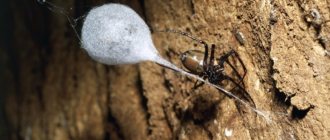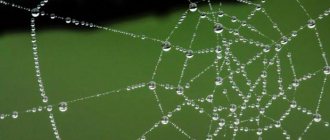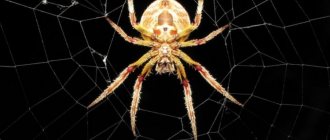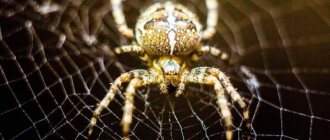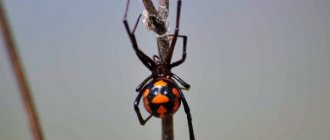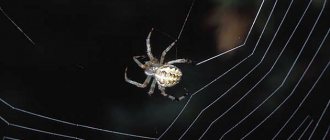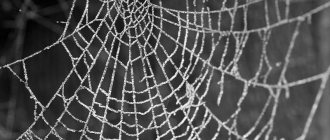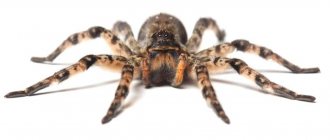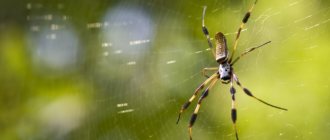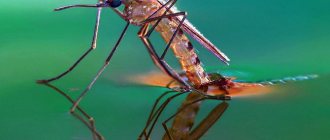Composition of the web
The chemical composition of the web is similar to silk, which is produced by some types of insects, for example, the silkworm. However, the strength of the substance produced by arachnids is much greater than the secretion of caterpillars.
Web
The web consists of two types of substances:
- organic;
- inorganic.
The main thread consists of fibroin. It is a water-insoluble protein consisting of a complex of simple proteins. It is this substance that gives the web its high strength and elasticity. Sericin is a component that provides the web with stickiness. Also on the list of ingredients are hydrogen phosphate and potassium nitrate. They have antiseptic properties and protect the thread from damage by fungi and bacteria.
Human use
Humanity has copied many constructive natural discoveries, but weaving a web is a very complex natural process, and at the moment it has not been possible to reproduce it qualitatively. Currently, scientists are trying to recreate the natural process using biotechnology based on isolating genes that are responsible for the reproduction of proteins that make up the web. Such genes are introduced into the cellular composition of bacteria or yeast, but modeling the spinning process itself is currently impossible.
Design features and types of web
Traps created by spiders of different species can differ quite noticeably from each other in their web-weaving technology and appearance. There are several main types of traps:
- Round. The most common. Thickened threads radiate from the center to the sides. They are connected by circles of different diameters, running from the center to the edges. An interesting fact is that the distance between all circles is approximately the same. The spider begins weaving such a web by tensioning the main threads. And then he pulls a thread of smaller thickness, and starting from the outer edge, connects the base with circular lines, the radius of which decreases as it approaches the center. During the hunt, the spider either remains in the center of the trap or sits at the end of the signal thread.
- Zigzag. Some species of arachnids form a zigzag web. This design attracts the attention of potential victims, and in addition, it is much more difficult to get out of it.
- Cone shaped. According to this pattern, traps are weaved by spiders from the funnel-web spider family. Most often, such funnels are located between the stems of plants, and the predator sits at the bottom, waiting for prey. When the prey approaches, the spider pulls it inside the cone.
- Formless. Sometimes there is a web in which it is difficult to detect any symmetrical structure. This is a shapeless jumble of threads. Such webs can often be seen in the corners of residential premises.
- A drop on a string. Mastophora cornigera spiders use uniquely shaped webs to catch insects. This is a small web ball attached to a strong thread. The ball is impregnated with pheromones and is very sticky. The predator lowers the ball on a string, swings it and thus catches prey. For this method of hunting, the spider was named Bolas, by analogy with throwing hunting weapons.
- Between the legs. The peculiarity of this form is not in the weaving of the web, but in its location. Gladiator spiders weave a small web, placing it between their front legs. They cover insects that happen to be nearby with a ready-made trap.
The design of the web will determine exactly how and for how long the spider weaves its web between trees or other supports.
Web rope
Dmitry Bagrov “Quantum” No. 4, 2010
Anyone can easily brush away cobwebs hanging between the branches of a tree or under the ceiling in the far corner of the room. But few people know that if the web had a diameter of 1 mm, it could withstand a load weighing approximately 200 kg. Steel wire of the same diameter can withstand significantly less: 30–100 kg, depending on the type of steel. Why does the web have such exceptional properties?
Some spiders spin up to seven types of threads, each of which has its own purpose. Threads can be used not only for catching prey, but also for building cocoons and parachuting (by taking off in the wind, spiders can escape from a sudden threat, and young spiders spread to new territories in this way). Each type of web is produced by special glands.
The web used to catch prey consists of several types of threads (Fig. 1): frame, radial, catcher and auxiliary. The greatest interest of scientists is the frame thread: it has both high strength and high elasticity - it is this combination of properties that is unique. Ultimate tensile strength of the frame thread of the spider Araneus diadematus
is 1.1–2.7. For comparison: the tensile strength of steel is 0.4–1.5 GPa, and that of human hair is 0.25 GPa. At the same time, the frame thread can stretch by 30–35%, and most metals can withstand deformation of no more than 10–20%.
Rice. 1.
Various threads in the web: the frame thread is the strongest, it holds the entire web together; the radial thread is thin and non-sticky, it supports the sticky catching thread; the auxiliary spiral helps position the catching thread. Image: Quantum
Let's imagine a flying insect that hits a stretched web. In this case, the thread of the web must stretch so that the kinetic energy of the flying insect is converted into heat. If the web stored the received energy in the form of elastic deformation energy, then the insect would bounce off the web like from a trampoline. An important property of the web is that it releases a very large amount of heat during rapid stretching and subsequent contraction: the energy released per unit volume is more than 150 MJ/m3 (steel releases 6 MJ/m3). This allows the web to effectively dissipate the impact energy and not stretch too much when a victim is caught in it. Spider web or polymers with similar properties could be ideal materials for lightweight body armor.
In folk medicine there is such a recipe: to stop the bleeding, you can apply a cobweb to a wound or abrasion, carefully clearing it of insects and small twigs stuck in it. It turns out that spider webs have a hemostatic effect and accelerate the healing of damaged skin. Surgeons and transplantologists could use it as a material for suturing, strengthening implants, and even as a blank for artificial organs. Using spider webs, the mechanical properties of many materials currently used in medicine can be significantly improved.
So, spider web is an unusual and very promising material. What molecular mechanisms are responsible for its exceptional properties?
We are accustomed to the fact that molecules are extremely small objects. However, this is not always the case: polymers are widespread around us, which have long molecules consisting of identical or similar units. Everyone knows that the genetic information of a living organism is recorded in long DNA molecules. Everyone was holding plastic bags in their hands, consisting of long intertwined polyethylene molecules. Polymer molecules can reach enormous sizes.
For example, the mass of one human DNA molecule is about 1.9·1012 amu. (however, this is approximately one hundred billion times more than the mass of a water molecule), the length of each molecule is several centimeters, and the total length of all human DNA molecules reaches 1011 km.
The most important class of natural polymers are proteins; they consist of units called amino acids. Different proteins perform extremely different functions in living organisms: they control chemical reactions, are used as building materials, for protection, etc.
Rice. 2.
Spidroin molecule and model of its folding in fiber. Image: Quantum
The skeleton thread of the web consists of two proteins, which are called spidroins 1 and 2 (from the English spider
- spider). Spidroins are long molecules with masses ranging from 120,000 to 720,000 amu. The amino acid sequences of spidroins may differ from spider to spider, but all spidroins have common features. If you mentally stretch out a long spidroin molecule in a straight line and look at the sequence of amino acids, it turns out that it consists of repeating sections that are similar to each other (Fig. 2). Two types of regions alternate in the molecule: relatively hydrophilic (those that are energetically favorable to contact with water molecules) and relatively hydrophobic (those that avoid contact with water). At the ends of each molecule there are two non-repetitive hydrophilic regions, and the hydrophobic regions consist of many repeats of an amino acid called alanine.
A long molecule (eg, protein, DNA, synthetic polymer) can be thought of as a crumpled, tangled rope. Stretching it is not difficult, because the loops inside the molecule can straighten out, requiring relatively little effort. Some polymers (such as rubber) can stretch up to 500% of their original length. So the ability of spider webs (a material made up of long molecules) to deform more than metals is not surprising.
Where does the strength of the web come from?
To understand this, it is important to follow the process of thread formation. Inside the spider gland, spidroins accumulate in the form of a concentrated solution. When the filament is formed, this solution leaves the gland through a narrow channel, this helps to stretch the molecules and orient them along the direction of the stretch, and the corresponding chemical changes cause the molecules to stick together. Fragments of molecules consisting of alanines join together and form an ordered structure, similar to a crystal (Fig. 3). Inside such a structure, the fragments are laid parallel to each other and linked to each other by hydrogen bonds. It is these areas, interlocked with each other, that provide the strength of the fiber. The typical size of such densely packed regions of molecules is several nanometers. The hydrophilic areas located around them turn out to be randomly coiled, similar to crumpled ropes; they can straighten out and thereby ensure the stretching of the web.
Rice. 3.
A recombinant spider web protein capable of forming special structures—thin filaments with a diameter of 3–5 nm. Image: Quantum
Many composite materials, such as reinforced plastics, are constructed on the same principle as the scaffolding thread: in a relatively soft and flexible matrix, which allows deformation, there are small hard areas that make the material strong. Although materials scientists have been working with similar systems for a long time, man-made composites are only beginning to approach spider webs in their properties.
Interestingly, when the web gets wet, it contracts greatly (this phenomenon is called supercontraction). This occurs because water molecules penetrate the fiber and make the disordered hydrophilic regions more mobile. If the web has stretched and sagged due to insects, then on a humid or rainy day it contracts and at the same time restores its shape.
Let us also note an interesting feature of the formation of the thread. The spider extends the web under the influence of its own weight, but the resulting web (thread diameter approximately 1–10 μm) can usually support a mass six times that of the spider itself. If you increase the weight of the spider by rotating it in a centrifuge, it begins to secrete a thicker and more durable, but less rigid web.
When it comes to using spider webs, the question arises of how to obtain it in industrial quantities. There are installations in the world for “milking” spiders, which pull out threads and wind them on special spools. However, this method is ineffective: to accumulate 500 g of web, 27 thousand medium-sized spiders are needed. And here bioengineering comes to the aid of researchers. Modern technologies make it possible to introduce genes encoding spider web proteins into various living organisms, such as bacteria or yeast. These genetically modified organisms become sources of artificial webs. Proteins produced by genetic engineering are called recombinant. Note that usually recombinant spidroins are much smaller than natural ones, but the structure of the molecule (alternating hydrophilic and hydrophobic regions) remains unchanged.
There is confidence that artificial web will not be inferior in properties to natural ones and will find its practical application as a durable and environmentally friendly material. In Russia, several scientific groups from various institutes are jointly studying the properties of the web. The production of recombinant spider web is carried out at the State Research Institute of Genetics and Selection of Industrial Microorganisms; the physical and chemical properties of proteins are studied at the Department of Bioengineering, Faculty of Biology, Moscow State University. M.V. Lomonosov, products from spider web proteins are formed at the Institute of Bioorganic Chemistry of the Russian Academy of Sciences, and their medical applications are studied at the Institute of Transplantology and Artificial Organs.
Where does a spider's web come from?
Speaking very generally and figuratively, a spider makes a web the same way as cotton candy is made. In the abdomen of the arthropod, a secretion is collected, which is formed in the internal arachnoid glands. There are 6 types of spider glands that produce threads for various purposes, such as creating a cocoon, for weaving the base of a web, for attaching a web, for covering the base. The set of glands in spiders of different species differs.
Wrapping a web around a victim
In the lower part of the spider's abdomen there are arachnoid warts - movable paired outgrowths, which in some species also serve as organs of touch. The surface of the outgrowths is covered with small hairs. These are arachnoid tubes, each of which is an internal duct of the gland. It is from these tubes that the web comes out. The area where the tubes are located is called the arachnoid field. In addition to the tubes, the web is secreted through chitinous cones, which are also located on the surface of the warts. These cones have a larger diameter and are the ducts of larger glands.
The secretion of the web is controlled by the spider's nervous system, regulating stickiness, thickness, even shade of color.
Web Strength
The web is the strongest substance of all artificially created materials. Its strength is usually measured in dernier (1g per 9000m). Thanks to scientists who performed calculations and measurements, it was possible to determine that the strength of the web is 6-8 dernier. That is, speaking in human language, it will break under the weight of its weight only if its length is more than 50 meters. It is also worth noting that the specific strength of the web is 2-3 times higher than the strength of steel
.
Its thickness is so small that it can only be noticed when rays of light fall on it. With its small thickness, the web is capable of stopping a flying bee or fly. On the belly of the spider there are many small depressions from which liquid is released. The main element of the released liquid is protein, which, when exposed to air, hardens as a result of oxidation and other related reactions.
When a spider secretes a substance, a thin thread is formed, and then this arthropod weaves it into a thicker and more durable fiber.
The role and significance of the web in the life of a spider
Undoubtedly, spiders primarily need webs to hunt. The woven network contains insects, which constitute the main diet of arachnids. But the web is not only a means of catching prey. In the life of spiders, it performs many different functions:
- Creation of a cocoon. The female weaves strong and comfortable cocoons from the web, in which she lays eggs. After hatching, the little spiders spend the first weeks of their lives in this cocoon, feeling completely protected from the external environment and enemies.
- Shelter. The web allows the arthropod to take shelter from bad weather and hide from enemies.
- Reproduction. Depending on the species, the female or male uses the thread of the web to attract the attention of the opposite sex. Either the male attaches his thread to the female’s network, informing her of his intentions, or the female secretes a thread impregnated with pheromones, by which she can be easily found.
- Vehicle. The strong and elastic structure of the spider web thread makes it an excellent means of transportation. With its help, spiders can move between trees or bushes, and even fly long distances, clinging to a web carried by a gust of wind.
- Protection. Some types of spiders use webs to glue debris together and make a dummy that looks like a spider. In case of danger, they pull the thread, the dummy moves, the predator is distracted, and the spider manages to leave the dangerous place.
Some aquatic species of spiders have air in their web sac, which allows them to stay underwater.
Types of fibers
The following types of fibers are also distinguished:
- Sticky (designed for catching prey)
- Strong (support the crossbars on which the spider moves and which do not stick)
- For cocoons (intended for eggs). There are both fluffy and soft, and hard and hard.
It is a known fact that spiders make various kinds of patterns in the form of spirals, crosses, etc. But not all spiders do this, but only some subspecies, the so-called araneomorphic spiders. Prey is caught in such “painted patterns” more often.
Why doesn't the spider stick to its web?
For a successful hunt, the spider must be able to move quickly and unhindered along the woven web. And he succeeds very well. Unlike its victims, the hunter does not stick to the threads and easily moves along them.
Spider's foot
He succeeds due to several factors:
- The spider's legs have many elastic hairs and claws. Moving along the web, the arthropod clings with its claws, pressing the thread to the hairs. When the spider lifts its leg, the claw unclenches and the hairs straighten, pushing away the web.
- The tips of the spider's legs are covered with a special oily substance.
- The predator moves along dry threads, which it specially weaves into a network to facilitate its movement.
Most often, in the center of the web there is a safe area where the spider waits for its victim.
Functions of the web and its purpose
Webs are used by spiders for a variety of purposes. A shelter woven from a strong and reliable web allows you to create the most favorable microclimatic conditions for arthropods, and also serves as a good shelter both from bad weather and from numerous natural enemies. Many arthropod arachnids are capable of weaving their web around the walls of their burrow or making it into a kind of door into their home.
This is interesting! Some species use webs as transport, and young spiders leave the parental nest on long web threads, which are picked up by the wind and transported over considerable distances.
Most often, spiders use webs to weave sticky trapping networks, which allows them to effectively catch prey and provide food to the arthropod. No less famous are the so-called egg cocoons made from webs, inside which young spiders appear . Some species weave web-like safety threads that protect arthropods from falling while jumping and for moving or catching prey.
Web for reproduction
The breeding season is characterized by the release of arachnoid threads by the female, which make it possible to find the optimal pair for mating. For example, male web-slingers are capable of constructing, next to the nets created by females, miniature mating web laces into which spiders are lured.
Male cross spiders deftly attach their horizontal webs to radially arranged strands of trapping webs made by females. By striking the web with strong blows with their limbs, the males cause the web to vibrate and, in this unusual way, invite the females to mate.
Web for catching prey
In order to catch their prey, many species of spiders weave special trapping nets, but some species are characterized by the use of peculiar web lassos and threads. Spiders that hide in burrow dwellings place signal threads that stretch from the arthropod’s abdomen to the very entrance to its shelter. When prey falls into the trap, the vibration of the signal thread is instantly transmitted to the spider.
Sticky spiral trapping nets are built on a slightly different principle . When creating it, the spider begins weaving from the edge and gradually moves towards the central part. In this case, the same gap between all turns is necessarily maintained, resulting in the so-called “Archimedes spiral”. The threads on the auxiliary spiral are specially bitten by the spider.
Web for insurance
Jumping spiders use web threads as insurance when attacking a victim. Spiders attach a safety thread of the web to any object, after which the arthropod jumps on the intended prey. The same thread, attached to the substrate, is used for overnight shelter and protects the arthropod from attacks by all kinds of natural enemies.
This is interesting! South Russian tarantulas, leaving their burrow home, pull behind them a thin web thread, which allows them to quickly find the way back or the entrance to the shelter if necessary.
Web as transport
By autumn, some species of spiders hatch their young. Young spiders that survive the process of growing up try to climb as high as possible, using trees, tall bushes, roofs of houses and other buildings, fences for this purpose. Having waited for a sufficiently strong wind, the small spider releases a thin and long web.
The distance of movement directly depends on the length of such a transport web. Having waited for a good tension of the web, the spider bites off its end and takes off very quickly. As a rule, “travelers” are able to fly several kilometers on a web.
Silver spiders use webs as water transport. To hunt in bodies of water, this spider requires breathing atmospheric air. When descending to the bottom, the arthropod is able to capture a portion of air, and on aquatic plants, a kind of air bell is constructed from the web, which retains air and allows the spider to hunt its prey.
What does a spider in a web tattoo mean?
Web with spider
- This is a famous
tattoo
of drug addicts who were in the zone.
In English colonies and prisons, such a tattoo means
that its wearer denies all laws, states and colonies, that is, it is a symbol of disobedience and independence.
Interesting materials:
What is the geolocation function for? Why is a cadet school needed? What is baking soda used for? Why is polishing needed? Why is Pre-sterilization cleaning needed? Why do you need the profession of a photographer? Why do you need a spiral in a shaker? What is the saucer for? Why do you need to add soda to jam? Why do you need to boil homemade milk?
The influence of ambient temperature on the web
The purpose of the second experiment was to study the reaction of the web to changes in ambient temperature (Appendix).
During the experiment, I used a plastic tightly closed container, branches with cobwebs, a refrigerator, and a thermometer.
Procedure of the experiment: I placed branches with cobwebs in a plastic tightly closed container and placed them in the freezer of the refrigerator for 24 hours. The air temperature in the freezer is minus 18ºС. After 24 hours, the appearance of the web did not change: its color remained the same, frost did not appear on the webs, it was not cold to the touch and remained sticky, the elastic properties of the web were preserved.
I placed new branches with cobwebs in one plastic tightly closed container, and in another identical container - branches with cobwebs that had just been removed from the freezer. The containers were placed in the sun (average air temperature - plus 30ºС) for 24 hours. After 24 hours, the appearance of the web did not change: its color remained the same, it was not warm to the touch and remained sticky, the elastic properties of the web were preserved, and no additional odor appeared in the plastic container with the web.
Conclusion: the appearance of the web, its quality and properties are not affected by high and low temperatures, as well as sudden changes in air temperature.
The smallest fibers in the natural environment
Scientists have long suspected that the web has such a unique structure. But it was very difficult to prove this. Many believed that spiders weave only individual fragments of their webs from nanofibers. Only the study of the web of “brown recluses” - as Loxosceles reclusa is colloquially called - led to a very interesting discovery. The fact is that the webs of almost all spiders are cylindrical in shape. But poisonous “hermits” make a web that looks like a flat ribbon. It is clearly visible under an atomic microscope, and its structure can be examined in great detail.
Of course, such a discovery was not made immediately. Biologists have conducted many experiments and studies. They published some of their findings a year ago. And recently they discovered that brown poisonous spiders also have a special technique for weaving webs. They work like sewing machines. They intersperse twenty special “stitches” made from the smallest fibers into every micromillimeter of their product. Thanks to them, the network becomes incredibly strong.
Elasticity of the web
To find out the properties of the web, I conducted six experiments. Observations of the web, collection of experimental material - the web was carried out in the period from August 1 to August 30, 2016 in the city of Taganrog and its environs.
The purpose of the first experiment was to study the elasticity of the web (Appendix).
In the experiment, I used a ruler, a web (the diameter of the web is 22 cm, the network has 15 circles), and a camera.
Progress of the experiment. I carefully brought a ruler close to the web (the diameter of the web in its original position is 22 cm). He moved the branches on which the web is attached to the sides:
— stretched the web by 1 cm and released the branches - the web returned to its original position: its diameter did not change, the threads of the web remained taut, as before stretching;
- stretched the web by 2 cm and stretched the branches - the web returned to its original position: its diameter did not change, the threads of the web remained taut;
- I stretched the web by 3 cm - the web broke.
Conclusion: the web is elastic and does not deform; under increased pressure it breaks (has a tensile strength).
Spider silk
Now, having uncovered the secret of strong spider webs, scientists will be able to create synthetic spider silk suitable for use in body armor and medical equipment. It is noteworthy that spider silk was discovered in ancient China and at the moment the price of one square meter of this material costs more than $500,000. The new discovery will not only reduce the cost of spider silk, but also give it additional strength.
Here's some more interesting stuff: Wasps turn spiders into "zombies" using a steroid hormone
If you are interested in science and technology news, subscribe to our channel in Yandex.Zen. There you will find materials that have not been published on our website.
How spiders weave webs
All types of spiders prefer to weave webs or stretch trap threads at night. At this time, optimal conditions are created: there is no heat, wind, sunlight, the air is sufficiently humidified.
To fix the thread to any surface, the spider presses the warts against it and then crawls away, dragging the hardening fiber along with it.
The thread is pulled using the hind legs, and its tension and position are simultaneously adjusted.
How a cross spider weaves a web:
- The spider chooses a place, releases the thread and waits until it catches on the support in free floating. The distance between attachment points can reach 2 m or more.
- Then the animal crawls to the other side of the thread, secures it, returns approximately 1/3 of the distance and hangs down, releasing another thread, which it fixes at an angle to the support located below.
- The spider returns upward to the supporting thread along an inclined thread, simultaneously releasing a new fiber, but without securing it. The end will be fixed to the supporting thread closer to its opposite end. This creates a web frame in the shape of an inverted triangle. There may be options in the form of a square or an irregular polygon.
- Internal radii are constructed in the plane of the frame (from 30 to 50). The spider does not pull them through a single point in the middle, but attaches them to a dense arachnoid plexus. Upon completion, he returns to the center and begins to connect the radii in a circle with temporary auxiliary jumpers (provisional spiral). The temporary spiral has few turns; the distance between them increases as you approach the edge of the frame.
- Once at the periphery, the spider turns around and begins to weave permanent bridges (a catching spiral of adhesive thread), biting the temporary ones and rolling them into lumps. The movement occurs in a tapering spiral from the edges to the center. The distance between the turns is already the same (“Achimedes spiral”).
If you calculate the approximate time it takes a spider to weave a web, you will get a range from 30 minutes to an hour. Upon completion, the animal extends a signal thread from the net, which it holds on to, waiting for prey on the side.
Any object caught in the trap is carefully examined and then either discarded or twisted into a cocoon. The spider itself does not stick to the adhesive fibers thanks to special hairs on its legs.
Not all spiders weave a trapping web. Some species hang on strong spider webs, waiting for prey, then pounce on it and quickly entangle it. Others sit in a hole and wait for the signal threads stretched nearby to vibrate.
Some weave nets in the form of a canopy, placing them horizontally. Such a web is supported by threads passing through it, fixed at the top and bottom.
Video
Spiders tune their webs like a guitar
Little spider
First, it’s worth talking about Darwin’s spider itself. This species was discovered in 2001 in Madagascar, but received a detailed scientific description only in 2009. It so happened that the moment of official recognition of the spider as a new species coincided with the 150th anniversary of the first publication of the book “On the Origin of Species,” in which the English naturalist Charles Darwin explained his theory of evolution. That is why the new species of spider was called “Darwinian”.
Darwin's spider (Caerostris darwini)
These spiders themselves are very small - the length of females reaches 18 millimeters, and the body length of males is approximately 6 millimeters. They usually spin webs over rivers and end up with a sticky and strong net for catching insects. The diameter of such a mesh is sometimes 2.8 meters, and the length of one thread can reach 25 meters.
By the way, some types of spiders even kill large animals.
Practical use
The discovery of scientists in the field of the structure of the web can play a huge role in the practical life of people. Imagine what would happen if we were able to synthesize the same super-strong and at the same time super-light threads, as happens in the natural environment! Construction and tailoring, medicine and the mining industry, even space exploration - it is difficult to find an area where such opportunities would not be useful. But the problem is that although scientists are trying, it is not yet possible to create such fibers, much less mass produce them. But thanks to such discoveries, we are step by step coming to new and absolutely amazing technologies that nature has been using for millions of years.
Found a violation? Report content
Burning web
The purpose of the fourth experiment was to study the characteristics of the combustion of spider webs (Appendix).
During the experiment, I used a metal rod with a web and matches.
I learned from adults that artificial polymer fabrics always melt when burned and often emit strong, unpleasant odors. If you set fire to a large piece of synthetic fabric, rubber or fishing line, its edges will seem to melt and even flow down in hot drops, and black smoke will be released. The burning of natural fabric differs from the burning of artificial fabric.
I set fire to the web and it caught fire. The flame is red in the middle, blue at the edges, without emitting black smoke. When burning, there is a pungent odor of burnt feathers.
Conclusion: the web burns, does not melt. This means it is of natural origin.
